




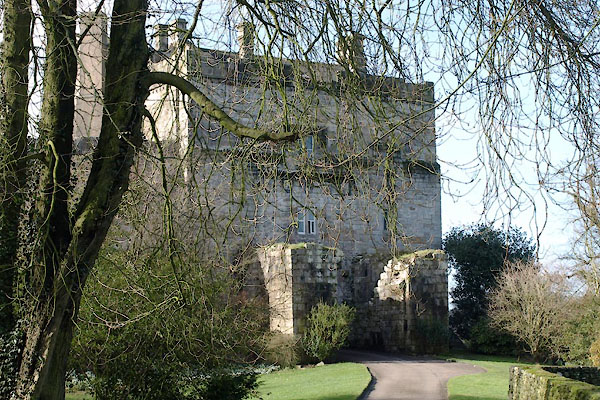
BVY52.jpg (taken 24.2.2012)
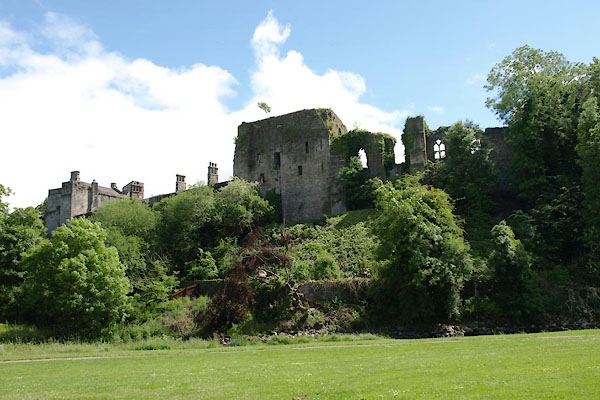
BYP55.jpg (taken 21.6.2013)
"Castle / Dungeons / Piazza / Gateway Tower / [Hag Tower] / ..."
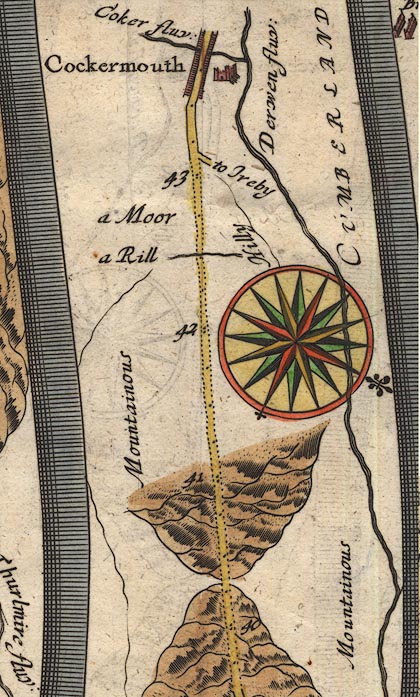
OG96m040.jpg
In mile 43, Cumberland.
castle on the right of the road in Cockermouth.
item:- JandMN : 22
Image © see bottom of page

OG96Bm10.jpg
In mile 14, Cumberland. "ye Cast:"
a castle beyond the River Cocker, right of the road.
item:- JandMN : 22
Image © see bottom of page
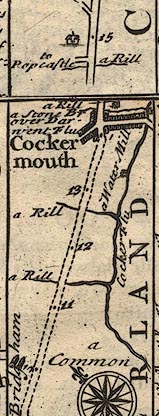
B261m10.jpg
"The Castle is mostly ruinous except that part where ye D. of Somersets Auditor keeps his Courts twice a year, & an apartment over ye Gates where is a large Dining Room, with other Chambers. Tho' his Grace has built a very convenient New House &c for his Bayliffs residence."
item:- Dove Cottage : Lowther.36
Image © see bottom of page
placename:-
"... At Cockermouth there is a castle which belongs to the same family [Piercy Family], ..."
placename:- Cockermouth Castle
 click to enlarge
click to enlargeBU0204.jpg
printed, top "THE NORTH-WEST VIEW OF COCKERMOUTH CASTLE, IN THE COUNTY OF CUMBERLAND."
printed, bottom "THIS castle was built soon after the Conquest, by William de Meschines, who first possess'd the Honour of Cockermouth by the Gift of his Brother Ranulph Earl of Cumberland. From the said William it came, for want of Male Issue, to Gilbert Pipard, and from Him, for the like Cause to Richard Lucy, by whose female Issue it became vested, in the Reign of K. Rich. II. A.D. 1384, in the Family of the Percies Earls of Northumberland, in which it continued till Josceline the last Earl, who left only a Daughter, married to His Grace Charles Seymour Duke of Somerset, who is, in Her Right, the present prroprietor. / 1. Cockermouth. - Saml. &Nathl. Buck delin. et Sculp: Publish'd according to Act of Parliament March 26th. 1739."
item:- Armitt Library : 1959.67.4
Image © see bottom of page
placename:- Cockermouth Castle
 goto source
goto source"Cockermouth-Castle, belonging to his Grace Charles Seymour, Duke of Somerset, Knight of the most noble Order of the Garter, who marry'd, for his first Lady, Catharine, sole Heiress of the Family of the Piercys, Earls of Northumberland, by whom he had this Estate with other large Possessions; ..."
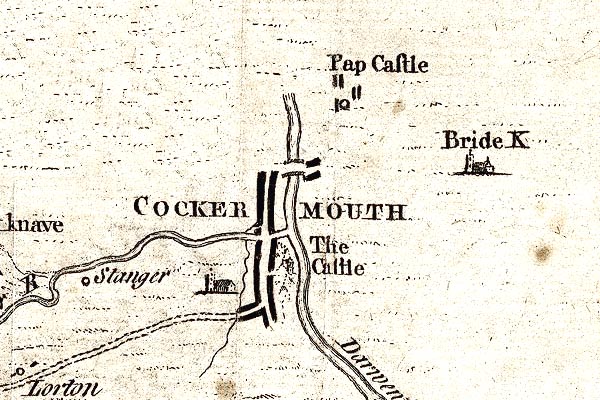
GM1304.jpg
"The Castle"
tower
item:- JandMN : 114
Image © see bottom of page
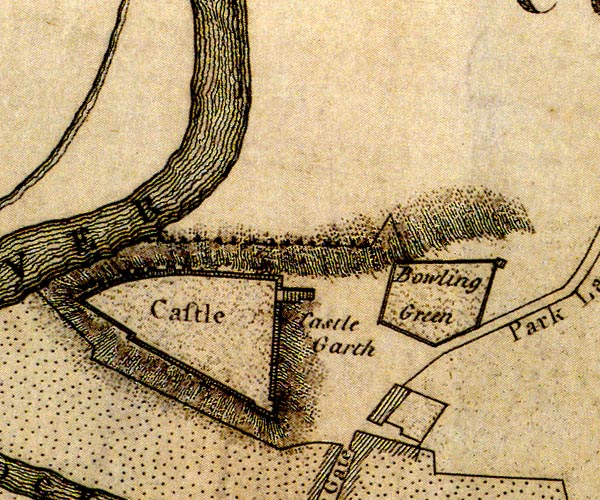
D41230J.jpg
"Castle / Castle Garth"
wall etc on hill
item:- Carlisle Library : Map 2
Image © Carlisle Library
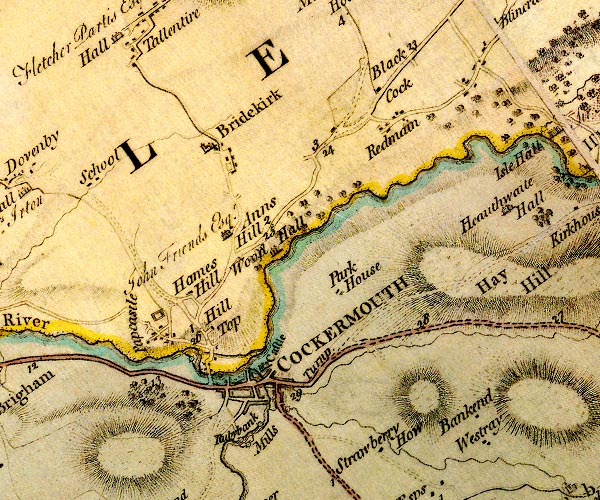
D4NY13SW.jpg
"Castle"
large building; a castle
item:- Carlisle Library : Map 2
Image © Carlisle Library
placename:- Cockermouth Castle
 goto source
goto sourcePage 105:- "..."
"I do not find any ancient authors mention a castle here [Castlerigg], Speed, who speaks of twenty-five in Cumberland, hath found out every one I ever heard or knew of, except Kirkoswald; how that has escaped him I cannot tell. I shall here put down their names, and, as well as I can, their most ancient owners, and supposed founders."
"..."
 goto source
goto sourcePage 106:- "..."
"22. COCKERMOUTH, - A noble building, with the arms of Moulton and Percy."
"..."
item:- coat of arms
 goto source
goto sourcePage 170:- "..."
"... Cokarmouth, a plentiful market town and castle of the earls of Northumberland. The town is handsomely built, but stands low between two hills, on one of which is the church, and on the other overagainst it the strong castle, over whose gate are the arms of Molton, Humfranville, Lucy, and Percy."
 goto source
goto sourcePage 183:- "... The castle [Cockermouth], built by Waltheof first lord of Allendale, and son of Gospatrick earl of Northumberland t. Conq. or by William de Meschines lord of the honor of Cockermouth, stands on an artificial hill, is square, and has several towers. On each side the second gate two spacious dungeons. It was burnt in the civil war. The town gives title of viscount to the earl of Egremont, to whom the castle came by the Percies as to them from the Lucies and Pipards."
item:- dungeon; gaol
 goto source
goto sourceGentleman's Magazine 1790 p.930 "Review of New Publications"
"... Observations Relative Chiefly to Picturesque Beauty ... William Gilpin ..."
"..."
"What would our modern philosophers say to the following manly and true remarks on the dismal dungeons of Cockermouth castle, II. 150? "It makes one shudder to think of a human creature shut up in those chambers of horror. How dreadful would it be for the people of these more polished times to be carried back into those barbarous periods when these savage practices existed! And yet there is such a correspondence throughout the whole system of manners in each aera, that people are happier, perhaps, under the entire habits of any one age than they would be under a partial change, even though that change were for the better. If we could all bear the mixture with such savage contemporaries, they would perhaps be as much discomposed with our polished manners. Nor did they feel, as we should, a compassion for that barbarous treatment which they were ready to suffer themselves from the chance of war.""
"..."
 goto source
goto sourceGentleman's Magazine 1799 opp p.281
 click to enlarge
click to enlargeG799E01.jpg
"North View of COCKERMOUTH CASTLE."
item:- coat of arms; Molton Family; Humphranville Family; Lucy Family; Percy Family
 goto source
goto sourceGentleman's Magazine 1799 p.281 "Staindrop, June 11."
"Mr. URBAN,"
"WITH this you will receive a drawing of Cockermouth castle, Cumberland; which I took but a few days ago; and, as I am informed no similar view has ever been published, I apprehend it will readily find a place in your valuable Miscellany. This castle stands upon a hill South of the river Dirwent, and West of the Cocker; it is very strong, and the walls are 600 yards in compass. On the East side, over the gate-way, are the arms of the Moltons, Humphranvilles, Lucys, and Percys. In this place are the remains of a vaulted cellar, and some walls of a chapel. It is supposed to have been built soon after the Conquest by William de Meschines."
"S. R."
 goto source
goto source"[Cockermouth] ... contains the ruins of a very ancient castle; which, from its situation and approach, must have been of great strength; it was chiefly destroyed when taken by the parliament forces in 1648. It belongs to the earl of Egremont, who takes the title of baron from the town. ..."
placename:- Cockermouth Castle
item:- Civil War; siege, Cockermouth
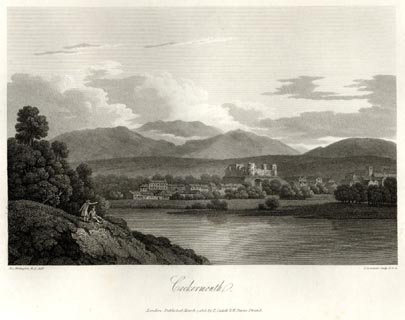 click to enlarge
click to enlargeFA0423.jpg
printed, bottom left, right, centre "Drawn by J. Farington R.A. / Engraved by J. Landseer A.R.A. / Cockermouth. / London Published March 7, 1816, by T. Cadell &W. Davies, Strand."
Descriptive text:- "VIEW OF COCKERMOUTH."
"..."
"Cockermouth Castle, the ancient baronial seat of the Lord of Allerdale, stands on a bold eminence, near the confluence of the rivers Cocker and Derwent. It is supposed to have been built soon after the Conquest; but there is no part of the present building which exhibits the architecture of so early a period. Cockermouth Castle is said to have been surrendered to King Henry IV. It is erroneously stated, in the History of this County by Nicolson and Burn, that it was made a garrison for the King in 1648, and that it was taken and burnt by the Parliamentary forces. It appears by Whitelock and Rushworth, that the castle being held by Lieutenant Bird, as Governor for the Parliament, was besieged for some weeks by a party of Cumberland Royalists, and that it was relieved by Colonel Ashton, who was sent out of Lancashire by Cromwell for that purpose. An entry in the registry of burials for the chapelry states, that the siege was laid against Cockermouth Castle in August, 1648, and the castle relieved the 29th of September, in which time were slain of the besiegers George Bucke, and one person only is said to have been shot in the garrison. It is probable, that, the castle, if not dismantled, was suffered to go to ruin after the civil war. A small part of it only is now habitable. In 1688 the only habitable part was the gateway and the court-house, where the Christmas sessions were held."
"..."
item:- Armitt Library : A6666.23
Image © see bottom of page
item:- siege, Cockermouth Castle
 goto source
goto sourceGentleman's Magazine 1819 part 1 p.506
From the Compendium of County History:- "1648. ... Cockermouth castle, under Lieutenant Bird, was besieged by the Royalists, from August to September 29, when the siege was raised by a detachment of Parliamentarians from Lancashire, under Colonel Ashton. ..."
placename:- Cockermouth Castle
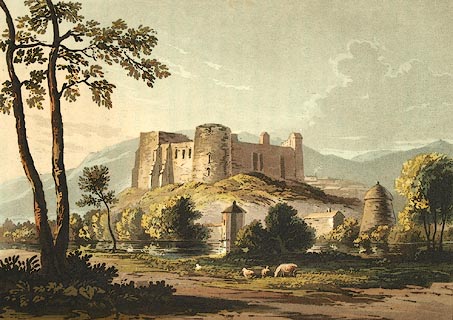 click to enlarge
click to enlargeFW0136.jpg
Tipped in opposite p.238 in A Picturesque Tour of the English Lakes.
item:- Dove Cottage : 1993.R566.36
Image © see bottom of page
 goto source
goto sourcePage 83:- "Remains of Castles of a more permanent construction are to be seen at Cockermouth, ... Part of that at Cockermouth has been repaired and is inhabited; ..."
item:- bowling green
 goto source
goto source"... The Norman conquerors, however, seem to have left this tract [The Lakes] wholly to itself: all the remains of the castles being found on the outskirts, as Egremont, Cockermouth, Brougham, and Kendal. ..."
 goto source
goto sourcePage 83:- "..."
"The castle stands on a bold elevation, strong by nature, between the Derwent and the Cocker, where it was built soon after the conquest, by Waldieve, first lord of Allerdale. It forms an irregular square, inclosed by strong walls, and defended at the entrance by a portcullis, drawbridge, and moat. On each side of the gate-way leading to the interior court is a deep dungeon. The south-west front, of which much still remains, stood on the brink of the precipice above the rivers, where appears to have been the state-room, and other apartments in the great tower. Under this tower is a vault thirty feet square, lighted by a small grated window, and approached by a descent of twelve steps, the roof upheld up by a single octagonal pillar, which branches out into ribs supporting the groining. This castle was kept in repair till the civil war, when it was reduced by the Parliamentarian forces and dismantled; since then it has lain in ruins, with the exception of the gate-house and the court-house at the east angle, which are kept in repair for the occasional residence of the lord of the manor. There is a bowling-green within"
 goto source
goto sourcePage 84:- "the walls. The gate-way tower is ornamented with the arms of the Umfranvilles, Multons, Lucies, Percies, and Nevilles, for to all these families this fortress has by turns belonged; the main body is covered with ivy, and with the walls and other towers forms a good study. ..."
 goto source
goto sourceGentleman's Magazine 1856 part 1 p.505 "Dr. Bruce, on the part of His Grace the Duke of Northumberland, presented to the society a copper coin, intended to serve as the representative of half-a-crown, and issued to replenish the ebbing exchequer of Charles the First. The piece was found at Cockermouth Castle."
item:- roman inscription; inscription, roman; roman fort, Papcastle
 goto source
goto sourceGentleman's Magazine 1866 part 1 p.201 "Antiquarian Intelligence and Proceedings of Learned Societies."
"-- Quid tandem velat
Antiqua miscere novis?"
"Notes of the Month"
"Cockermouth Castle, Cumberland. - The Rev. Dr. Bruce has brought before the Society of Antiquaries of Newcastle-upon-Tyne, an inscription upon a stone slab, excavated last summer at Cockermouth Castle, which is generally believed to be indebted for most of its material to the ruins of Papcastle, once a strong Roman fortified post, the original name of which has not been satisfactorily ascertained. The upper part of the inscription, apparently to the extent of three or four lines, is entirely wanting: the first line of what remains is very defective, and a word in the fourth has been so mutilated as to be rendered almost, if not quite, illegible; but the most material part is perfectly clear, and is as follows, with the exception that some of the letters are combined or in ligature:"
"....G AVG. II....
NVM. FRISON
VM. ABALLAV
ENSIVM .....
. XIIII KAL ET XIII KAL
NOV. GOR. II. ET POMPEI.
COS. ET ATTICO ET PRETE
XTATO COS. V. S. L. M."
"- numerus Frisonum Aballavensium ..... decimo quarto Kalendis et decimo tertio Kalendis Novembris Gordiano secundo et Pompeiano consulibus et Attico at Pretextato consulibus votum solventes (or solverunt) lubenter ,merito."
"The G in the first line has probably formed part of LEG (legatus); and it is equally probable the letters indicated after AVG. were PR. PR. (propraetor) followed by ET; the full sense being that some person of official rank on some public occasion had dedicated, in discharge of a vow to some deity or deities, a building, in conjunction with a numerus of the Aballavensian Frisiones, on the fourteenth and thriteenth calends November, in the consulates of Gordian (second time consul) and Pompeianus, and of Atticus and Pretextatus, answering to A.D. 214, when Gordianus Pius was emperor."
"The inscription enables us to understand that a body of Frisiones had been quartered sufficiently long at a station called Aballava to acquire the surname Aballavenses. This Aballava is recorded in the Notitia among the stations per lineam valli as being garrisoned, under a praefect, by a numerus of Moors, called Aurelian. But it is somewhat remark-"
 goto source
goto sourceGentleman's Magazine 1866 part 1 p.202 "[remark]able that, while all the stations upon the wall from the first or easternmost have been identified without much, if any, doubt, Aballava has hitherto baffled the inquiries and explorations of the most active and expert invesigators. Horsley placed it at Watch-cross or Watch-close, a locality altogether wanting in the indicia of a permanent military post. The late Rev. John Hodgson, with more show of reason, locates it at Stanwix, but chiefly from its position in the Notitia, the fourteenth station from Wallsend; Petriana, the thirteenth, being Walton Chesters. He remarks "that it had its name from contiguity to the wall, I cannot doubt; for alla, falla, and balla, in the old language of Britain and the present speech of Ireland, are synonymous to vallum in Latin and wall in English." a Dr. Bruce, who more than any one has studied the wall and its stations, hesitates to identify the site of Aballava, and also of some other stations to the west of Petriana. Papcastle, where, no doubt, the inscription under consideration was originally found, is away from the the line of the wall, and of course has no claim to be considered as Aballava; but it falls into another series of the Notitia stations, the sites of most of which have by no means been positively ascertained; and, notwithstanding researches from Camden to the present day, much remains to reward careful and personal explorations. A valuable instalment will no doubt be given in Dr. Bruce's third edition of his "Roman Wall," now passing through the press, which will contain, among much additional matter, a full and illustrated of Mr. Clayton's discovery of the remains of a Roman bridge over the North Tyne at Chesters, the Cilurnum of the Notitia."
"The Frisiones of this inscription are no doubt the Frisiani of the rescript of Trajan found at Sydenham, of whom lapidary records have been dsicovered at Binchester and at Melandra Castle; and at the same time they are probably the same as the Frixagi of the Notita stationed at Vindobala on the Wall."
"... ..."
"a The Roman Wall and South Tindall, p.219."
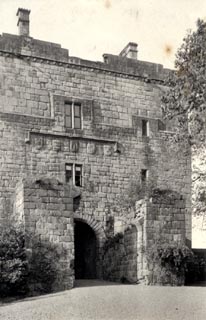 click to enlarge
click to enlargeHB0440.jpg
item:- Armitt Library : ALPS95
Image © see bottom of page
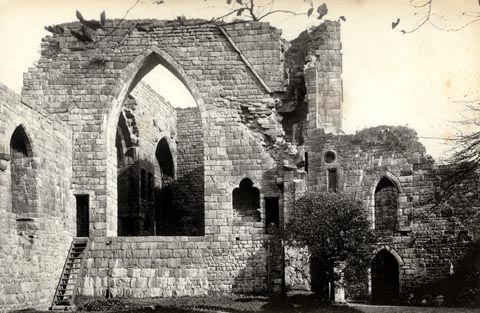 click to enlarge
click to enlargeHB0439.jpg
item:- Armitt Library : ALPS94
Image © see bottom of page
item:- coat of arms
 click to enlarge
click to enlargeHB0320.jpg
item:- Armitt Library : ALPS679
Image © see bottom of page
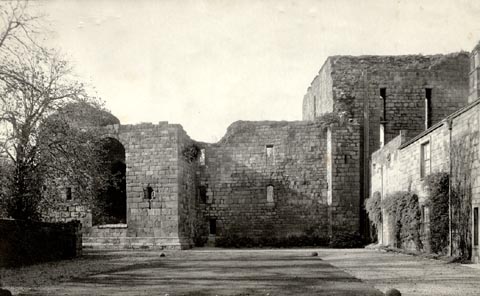 click to enlarge
click to enlargeHB0321.jpg
item:- Armitt Library : ALPS680
Image © see bottom of page
item:- sluice gear
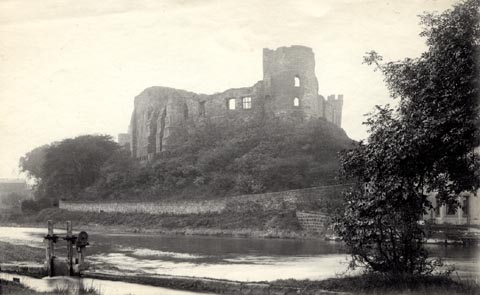 click to enlarge
click to enlargeHB0322.jpg
item:- Armitt Library : ALPS681
Image © see bottom of page
placename:- Cockermouth Castle
 click to enlarge
click to enlargeBRL120.jpg
On page 100 of Highways and Byways in the Lake District, by A G Bradley.
printed at bottom:- "Cockermouth Castle."
item:- JandMN : 464.20
Image © see bottom of page
placename:- Cockermouth Castle
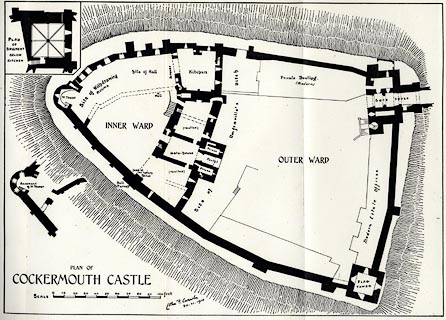 click to enlarge
click to enlargeCW0123.jpg
Tipped in opposite p.132 of The Castles and Fortified Towers of Cumberland, Westmorland, and Lancashire North of the Sands, by John F Curwen.
printed at lower left:- "PLAN OF / COCKERMOUTH CASTLE / John F. Curwen / 30.vi.1910"
item:- Armitt Library : A782.23
Image © see bottom of page
placename:- Cockermouth Castle
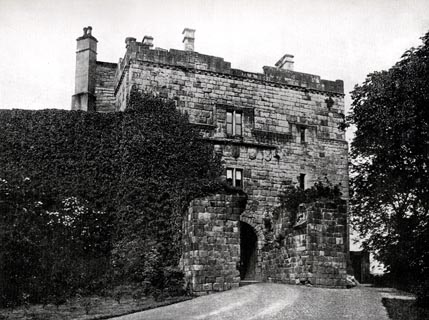 click to enlarge
click to enlargeCW0122.jpg
Tipped in opposite p.130 of The Castles and Fortified Towers of Cumberland, Westmorland, and Lancashire North of the Sands, by John F Curwen.
printed at bottom:- "COCKERMOUTH CASTLE: THE GATEHOUSE."
item:- Armitt Library : A782.22
Image © see bottom of page
placename:- Cockermouth Castle
courtesy of English Heritage
"COCKERMOUTH CASTLE (RESIDENCE OF LORD EGREMONT) / / CASTLEGATE / COCKERMOUTH / ALLERDALE / CUMBRIA / I / 71652 / NY1224830886"
courtesy of English Heritage
"Occupies the north side of the outer ward, formerly separate cottages, now 1 house, late Georgian in character, stone, 2 storeys, 8 sash windows on upper floor, 3 doors and sashes on ground floor, most windows 12-paned with plain stone architrave. Slate roof and stone chimneys, the east end adjoining the Gatehouse."
"The inhabited parts of Cockermouth Castle form a group with the uninhabited parts."
placename:- Cockermouth Castle
courtesy of English Heritage
"COCKERMOUTH CASTLE (UNINHABITED PARTS) / / CASTLEGATE / COCKERMOUTH / ALLERDALE / CUMBRIA / I / 71651 / NY1221230882"
courtesy of English Heritage
"Ancient Monument (Scheduled). The site is on a promonotory between the Rivers Cocker and Derwent, and there has been a castle since before 1221. The Hall, 1360, Flag Tower 1387, Gatehouse rebuilt circa 1400. Full curtain walls and 2 wards. Masonry in good order externally. Ref. Curwen, "Castles", p, 127. An important building in a fine setting."
"The inhabited parts of Cockermouth Castle form a group with the uninhabited parts"
courtesy of English Heritage
"BOWLING GREEN HOUSE IN GROUNDS OF COCKERMOUTH / / CASTLEGATE / COCKERMOUTH / ALLERDALE / CUMBRIA / II / 71657 / NY1237830896"
courtesy of English Heritage
"SOUTHERN RANGE OF BUILDINGS, ADJOINING THE FLAG TOWER (INCLUDING GARAGES, STORE ROOMS AND CASTLE COTTAGE / / CASTLEGATE / COCKERMOUTH / ALLERDALE / CUMBRIA / I / 71655 / NY1224330839"
courtesy of English Heritage
"GARDEN WALLS OF THE CASTLE SOUTH OF BOWLING GREEN HOUSE / / CASTLEGATE / COCKERMOUTH / ALLERDALE / CUMBRIA / II / 71658 / NY1233430859"
courtesy of English Heritage
"Mainly old brick, probably C18. High walls enclosing the former bowling green and separating the Castle grounds from the street."
"The inhabited parts of Cockermouth Castle form a group with the uninhabited parts."
courtesy of English Heritage
"OUTER GATEHOUSE / / CASTLEGATE / COCKERMOUTH / ALLERDALE / CUMBRIA / I / 71653 / NY1227130882"
courtesy of English Heritage
"C14, vaulted, with round arch and spiral stair. The upper rooms communicate with Lord Egremont's house and also the east range of buildings."
"The inhabited parts of Cockermouth Castle form a group with the uninhabited parts"
courtesy of English Heritage
"LORD EGREMONT'S ESTATE OFFICE AND THE OFFICE OF THE WESTMORLAND GREEN SLATE COMPANY / / CASTLEGATE / COCKERMOUTH / ALLERDALE / CUMBRIA / I / 71654 / NY1227030857"
courtesy of English Heritage
"PUMP INSIDE THE OUTER GATEHOUSE / / CASTLEGATE / COCKERMOUTH / ALLERDALE / CUMBRIA / I / 71656 / NY1226230876"
courtesy of English Heritage
"Square stone pier with chamfered panelled corners and curved capping. Iron curved handle and wooden pipe. Stone trough, square with circular basin."
"The inhabited parts of Cockermouth Castle form a group with the uninhabited parts."
placename:- Cockermouth Castle
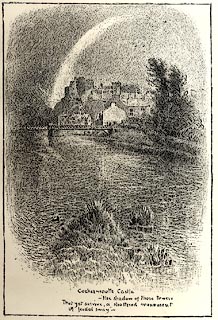 click to enlarge
click to enlargePR1572.jpg
Tipped in opposite p.2 of Through the Wordsworth Country, by William Knight.
printed at lower centre:- "Cockermouth Castle / -the shadow of those towers / That yet survive, a shattered monument / O feudal sway -"
item:- JandMN : 382.2
Image © see bottom of page
placename:- Cockermouth Castle
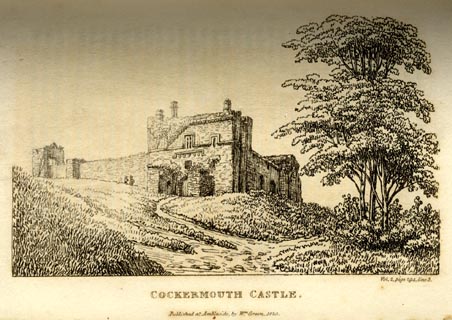 click to enlarge
click to enlargeGN0129.jpg
Tipped in opposite vol.2 p.294 of The Tourist's New Guide, by William Green.
printed at bottom right, centre:- "Vol.2, page 294, line 3. / COCKERMOUTH CASTLE. / Published at Ambleside, by Wm. Green, 1820."
item:- Armitt Library : A1141.30
Image © see bottom of page
placename:- Cockermouth Castle
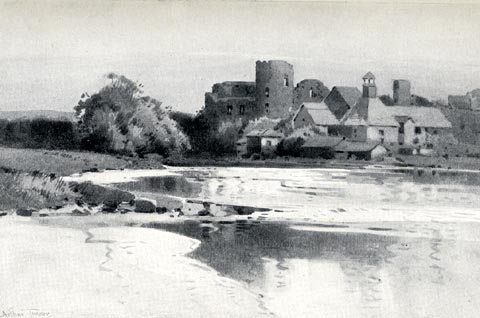 click to enlarge
click to enlargeRSN107.jpg
Tipped in opposite p.20 of Wordsworthshire by Eric Robertson.
Jenning's brewery in front?
printed at bottom:- "COCKERMOUTH CASTLE"
signed at painting lower left:- "Arthur Tucker"
item:- JandMN : 197.7
Image © see bottom of page
placename:- Cockermouth Castle
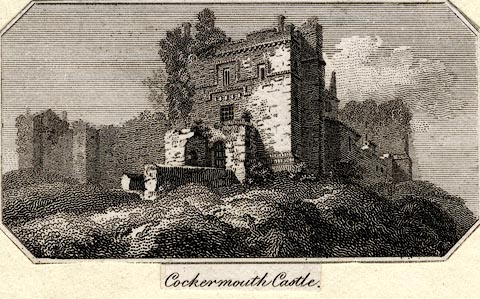 click to enlarge
click to enlargePR0445.jpg
printed at bottom:- "Cockermouth Castle."
item:- private collection : 109
Image © see bottom of page
placename:- Cockermouth Castle
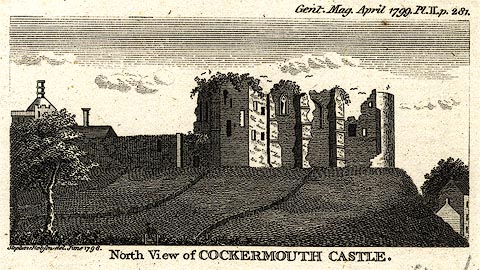 click to enlarge
click to enlargePR0270.jpg
printed at top right:- "Gent. Mag. April 1799. Pl.II p.281."
printed at bottom left, centre:- "Stephens Robson del. June 1798. / North View of COCKERMOUTH CASTLE."
item:- Dove Cottage : 2008.107.270
Image © see bottom of page
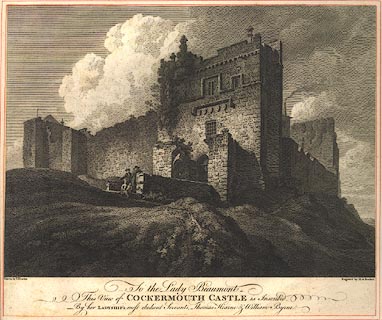 click to enlarge
click to enlargeBMZ80.jpg
Plate 12 ?from the Antiquities of Great Britain, published 1786-1807; with descriptive text:- "COCKERMOUTH CASTLE"
"Is seated on an artificial mount at the confluence of the rivers Cocker and Derwent: the walls are of considerable extent, and bear evident marks of its being formerly a place well calculated for defence."
"Concerning the founder of this Castle authors differ; some attribute its origin to Waldeof, first Lord of Allerdale, and son of Gospatrick Earl of Northumberland, in the time of William the Conqueror. By others we are told it was built by William de Meschines, who enjoyed the Honour of Cockermouth by gift of his brother Ranulph Earl of Chester, to whom the Conqueror had given the whole county of Cumberland."
"The baronial Honour of Cockermouth, with that of Egremont, descended by marriages to the De Lucies, and to the Percies of Northumberland; and afterwards to Charles Seymour Duke of Somerset, and finally to the present Earl of Egremont."
"During the civil war in the reign of Charles I. this Castle was garrisoned for the King; but being besieged and taken, was burnt, since which the inside has remained in ruins."
"The exterior walls of this Castle are nearly square, and are decorated by several towers and bastions of the same figure, and one of a circular form that stands at the west end, and overlooked the conflux of the rivers. The interior part of the Castle is divided by the remaining walls into three distinct areas; the least of which affords an ample garden, for the use of the person who inhabits an apartment in the outer area, and takes care of the Castle."
"The Print represents the north-east aspect, and entrance to the Castle. Over the gate are seen five shields, four of them, according to Cambden, bear the arms of the Moultons, Humfranvilles, Lucies, and Percies, and the other is said to belong to the Nevils. In this Tower, over the gate-way, are some habitable rooms, which are furnished for the convenience of the auditor who holds his courts in this Castle."
"The View was taken in 1777."
item:- Dove Cottage : Lowther.43
Image © see bottom of page
 click to enlarge
click to enlargeBMZ83.jpg
"COCKERMOUTH CASTLE, CUMBERLAND."
"(PLATE I.)"
"THIS was the baronial castle of the honour of Cockermouth, built, as is supposed, soon after the Conquest by William de Meschines, who possessed that honour by gift of his brother Ranulph, earl of Cumberland; to whom the Conqueror gave all that part of Cumberland called Copeland, lying between the Duddon and the Derwent."
"FROM the said William this honour, for want of heirs male, came to Gilbert Pipard; and from him, for the like cause, to Richard de Lucy; whose daughter and co-heiress marrying Thomas de Moulton, had issue a son Anthony, who took upon him the name Lucy; and to him, as it appears in Madox's Baronia, this honour, together with the manor of Pappe Castle, were granted by Edward III. in the second year of his reign. This Anthony dying without issue, his estates devolved to his sister Maud, who first married Gilbert de Umfraville, and afterwards Henry de Percy, earl of Northumberland. She did, by a fine levied in the Octaves of St. John Baptist, in the reign of King Richard II. A.D. 1384, settle the castle and honour of Cockermouth, with a large proportion of her inheritance, upon her husband and his heirs male, with diverse remainders to the family of the Percy's, upon condition that they should always bear the arms of Lucy, which are, gules, three luces or pikes, hauriant, argent, in all shields, banners, ensigns, and coats of arms whatsoever, quarterly with their own. In this family it continued till Joceline, the last earl, leaving only a daughter, she carried it in marriage to Charles Seymour, duke of Somerset; and by the death of Algernon (the last duke) without heirs male, it descended, together with the title of earl of Egremont, to Sir Charles Wyndham, Bart. whose son is the present proprietor."
"OTHER accounts attribute the building of this castle to Waldof, first lord of Allerdale, son of Gospatrick, earl of Northumberland, cotemporary with William the Conqueror. Waldof, it is said, resided first at Pappe Castle in this neighbourhood; which he afterwards demolished, and with the materials erected this edifice."
"THIS castle stands on the west side of the Coker, on a mount, seemingly artificial, near the Darwent. The dimensions of the walls, which form nearly a square, are computed about 600 yards in compass; they are flanked by several square towers. The entrance is on the east side over a bridge. Over the outer gate are five shields of arms; four of them are said to be those of Moulton's, Umfraville's, Lucy's, and Percy's. In this gate are some inhabitable rooms, wherein the auditor holds a court twice every year."
"WITHIN the walls are two courts: in the first are some small modern tenements inhabited by a person who takes care of the castle. From this court, through a gate, is the entrance into a second. On each side of this gate are two deep dungeons, each capable of holding fifty persons; they are vaulted at the top, and have only a small opening in order to admit the prisoners, who either descended by a ladder, or were lowered down with ropes. On the outside of the gate, just even with the ground, are two narrow slits; one on each side, sloping inwards. Down these were thrown the provisions alloted for the wretched beings confined there, who had no other light or air but what was admitted through these chinks."
"WITHIN the second court stood the mansion, now in ruins. The Kitchen, as it is called, makes a picturesque appearance. It has one of those monstrous chimneys, so common in old mansions, which serve to give an idea of the ancient hospitality. Under it is a groined vault, said to have been the chapel, supported near the middle by a large polygonal column, and lighted by only one window."
"DURING the civil war it was garrisoned, anno 1648, for the king; and being besieged and taken, was burned, and never since repaired; although the present earl has caused the outer walls to be new pointed, and the rubbish to be removed from the inner court."
"This view, which represents the north-east aspect, was drawn anno 1774."
item:- Dove Cottage : Lowther.46
Image © see bottom of page
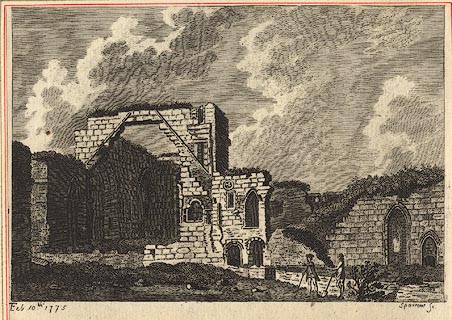 click to enlarge
click to enlargeBMZ84.jpg
"COCKERMOUTH CASTLE, CUMBERLAND."
"PLATE II."
"THE former view exhibited the outside of this Castle; this shews the inside of its inner Court, view'd nearly in the contrary direction."
"THE great room called the kitchen is here very perspicuous. Towards the right hand, and near its top, appear the remains of a stair-case."
"THE small door near the middle of the Plate, with an inner arch appearing just above the wall, is tat which leads to the stair-case, descending into the chapel."
"UNDER the largest of the two pointed arches, towards the right hand, lies the passage to and from the outer court."
"This view was drawn anno 1774."
item:- Dove Cottage : Lowther.47
Image © see bottom of page
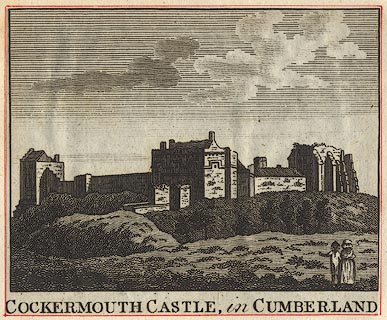 click to enlarge
click to enlargeBMZ85.jpg
item:- Dove Cottage : Lowther.48
Image © see bottom of page
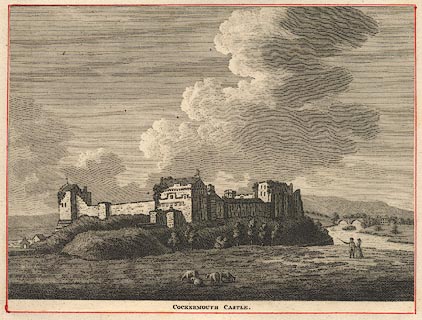 click to enlarge
click to enlargeBMZ82.jpg
item:- Dove Cottage : Lowther.45
Image © see bottom of page
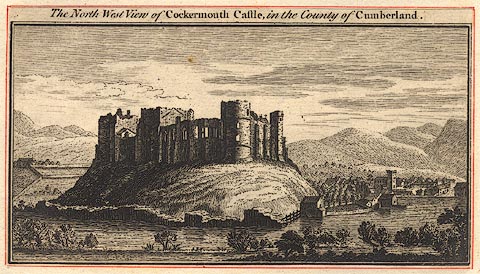 click to enlarge
click to enlargeBMZ81.jpg
item:- Dove Cottage : Lowther.44
Image © see bottom of page
placename:- Cockermouth Castle
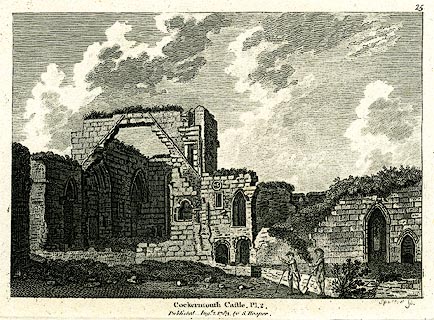 click to enlarge
click to enlargePR0209.jpg
printed at top right:- "25"
printed at bottom right, centre:- "Sparrow Sc. / Cockermouth Castle, Pl.2. / Published 21 Augt. 1. 1783 by S. Hooper"
item:- Dove Cottage : 2008.107.209
Image © see bottom of page
placename:- Cockermouth Castle
 click to enlarge
click to enlargePR0208.jpg
printed at top right:- "Pl.1."
printed at bottom:- "COCKERMOUTH CASTLE. / Pub'd 21 Decr. 1783 by S. Hooper"
item:- Dove Cottage : 2008.107.208
Image © see bottom of page
placename:- Cockermouth Castle
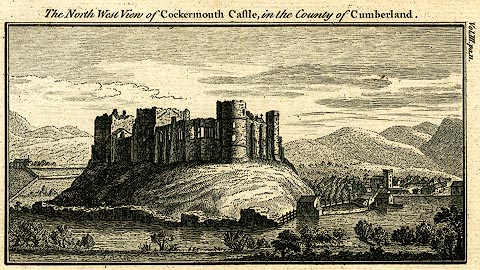 click to enlarge
click to enlargePR0183.jpg
Included in vol.3 p.11 of a set of castle pictures?
printed at bottom:- "The North West View of Cockermouth Castle, in the County of Cumberland."
printed at top left of page:- "Vol.III pa.11."
item:- Dove Cottage : 2008.107.183
Image © see bottom of page
placename:- Cockermouth Castle
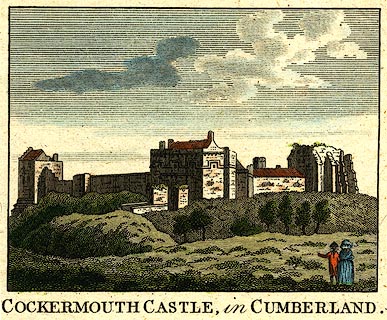 click to enlarge
click to enlargePR0269.jpg
printed at bottom:- "COCKERMOUTH CASTLE, in CUMBERLAND."
item:- Dove Cottage : 2008.107.269
Image © see bottom of page
Bradbury, J Bernard: 1983: Cockermouth in Pictures, 3 the Castle
